Vertical Shmups
For some reason, there has long been a debate as to which are better: horizontal or vertical shmups. Why people even waste their time arguing this is beyond me. A great game is a great game, regardless of the direction it scrolls. For every great horizontal shmup someone identifies, an equally awesome vertical one can be found. Both types have their attractions, and both should be played with the same fervor and energy. I can’t say that I have a preference between the two, and since I’m no shmupping guru, I’m not even going to attempt to wade into that debate.
The  Series
Series
 Both the Genesis and the Sega CD were lucky enough to receive two of the six Aleste games. M.U.S.H.A. (Metallic Uniframe Super Hybrid Armor) and Robo Aleste are widely regarded as the two best vertical shmups on the platform. Though Robo Aleste is an awesome game that takes the twitch gameplay from the series to a stunning climax (form what I’m able to gather, it’s the last game in the series), fans clamor to M.U.S.H.A. as the best all around. They aren’t stabbing in the dark either. Upon its release, the game left many jaws nailed to the floor with its incredible graphics and rocking soundtrack. Multiple weapons, each with several levels of power, and a crapload of option assists rounded out an already stellar package. Also, check out our review of Robo Aleste!
Both the Genesis and the Sega CD were lucky enough to receive two of the six Aleste games. M.U.S.H.A. (Metallic Uniframe Super Hybrid Armor) and Robo Aleste are widely regarded as the two best vertical shmups on the platform. Though Robo Aleste is an awesome game that takes the twitch gameplay from the series to a stunning climax (form what I’m able to gather, it’s the last game in the series), fans clamor to M.U.S.H.A. as the best all around. They aren’t stabbing in the dark either. Upon its release, the game left many jaws nailed to the floor with its incredible graphics and rocking soundtrack. Multiple weapons, each with several levels of power, and a crapload of option assists rounded out an already stellar package. Also, check out our review of Robo Aleste!
I really like Robo Aleste but I’m the first to admit that it doesn’t hold up to its Genesis sibling. The storyline is kind of hard to swallow (M.U.S.H.A.‘s story is great) and the gameplay just doesn’t seem to flow the same way. Should you buy it? By all means. It’s a wonderful game that ends the series with a bang. The music alone is worth the price of admission.
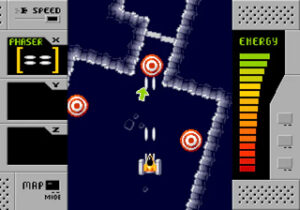 Another excellent aftermarket release, Arkagis Revolution is an impressive game that takes the Genesis hardware to places most people never thought it could reach by blending shooting and exploration with labyrinthine stages presented in Mode 7-style visuals. Players navigate by rotating the stage and shooting enemies while collecting power-ups, and the game offers convenient features like password saving accessible through the map and mid-stage checkpoints. The gameplay is fast-paced and responsive, and Mega Cat Studios upped the ante by including compatibility with various controllers, including the standard and six-button options, as well as the Sega Mouse and Sega Saturn keyboard. There’s simply nothing else like it on Genesis.
Another excellent aftermarket release, Arkagis Revolution is an impressive game that takes the Genesis hardware to places most people never thought it could reach by blending shooting and exploration with labyrinthine stages presented in Mode 7-style visuals. Players navigate by rotating the stage and shooting enemies while collecting power-ups, and the game offers convenient features like password saving accessible through the map and mid-stage checkpoints. The gameplay is fast-paced and responsive, and Mega Cat Studios upped the ante by including compatibility with various controllers, including the standard and six-button options, as well as the Sega Mouse and Sega Saturn keyboard. There’s simply nothing else like it on Genesis.
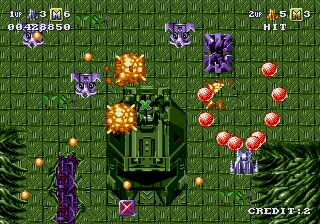 Electronic Arts releasing a shmup? How’s that for weird? Done in the same mold as the classic Toaplan shmup, like Twin Cobra (arcade), and Fire Shark, Battle Squadron lacks all of the charm of those titles and is simply too generic for its own good. The genre was in a bit of a rut on the Genesis in 1990, with most titles looking very much like each other, and that’s what we have here. There are a few cool things though, like the two-player simultaneous option, and the ability to determine how many enemy shots will be onscreen at once and their speed (in the options menu). The cloaked enemy ships are a neat feature as well. The only real problem I had with Battle Squadron was in its gameplay. Being allowed to retain a power up after death is useless when the initial invincibility your new ship receives is barely enough to make it onscreen. Seriously, you’ll find yourself losing a life practically before you even realize that it was there. The painfully slow movement of your vessel doesn’t help matters much, and enemies take far too long to kill sometimes (what’s with the power up capsule? It’s fricken’ invincible!). If you can get through these problems, you might actually enjoy Battle Squadron. Just don’t pay over $5 for it.
Electronic Arts releasing a shmup? How’s that for weird? Done in the same mold as the classic Toaplan shmup, like Twin Cobra (arcade), and Fire Shark, Battle Squadron lacks all of the charm of those titles and is simply too generic for its own good. The genre was in a bit of a rut on the Genesis in 1990, with most titles looking very much like each other, and that’s what we have here. There are a few cool things though, like the two-player simultaneous option, and the ability to determine how many enemy shots will be onscreen at once and their speed (in the options menu). The cloaked enemy ships are a neat feature as well. The only real problem I had with Battle Squadron was in its gameplay. Being allowed to retain a power up after death is useless when the initial invincibility your new ship receives is barely enough to make it onscreen. Seriously, you’ll find yourself losing a life practically before you even realize that it was there. The painfully slow movement of your vessel doesn’t help matters much, and enemies take far too long to kill sometimes (what’s with the power up capsule? It’s fricken’ invincible!). If you can get through these problems, you might actually enjoy Battle Squadron. Just don’t pay over $5 for it.
 I must admit that I wasn’t expecting all that much when I first booted up Crossfire. Imagine my surprise when I found out what a great game it is! Based on the 80 series Airwolf (the game is called Super Airwolf outside of Japan), it plays very Toaplan-esque, but actually adds some new dynamics to that established formula. For example, your helicopter has a a turbo option that creates an impenetrable shield around it for a small time, letting you get through some tough situations. Moreover, you can choose your craft’s armament between stages. The standard bomb set for wiping out foes is present as well, but the most interesting feature here is the addition of run-‘n-gun levels. After you pass a stage, you have to infiltrate the area and complete an objective. This is done by plowing through enemy infantry in your copter until you reach the drop zone. Once there, you take command of your second crewman in Ikari Warrior-style levels. The graphics and sound are decent, and the gameplay is great, and I was very pleased with its innovation, given that it was released pretty early in the Genesis’ cycle. Crossfire is a sleeper that deserves to be checked out.
I must admit that I wasn’t expecting all that much when I first booted up Crossfire. Imagine my surprise when I found out what a great game it is! Based on the 80 series Airwolf (the game is called Super Airwolf outside of Japan), it plays very Toaplan-esque, but actually adds some new dynamics to that established formula. For example, your helicopter has a a turbo option that creates an impenetrable shield around it for a small time, letting you get through some tough situations. Moreover, you can choose your craft’s armament between stages. The standard bomb set for wiping out foes is present as well, but the most interesting feature here is the addition of run-‘n-gun levels. After you pass a stage, you have to infiltrate the area and complete an objective. This is done by plowing through enemy infantry in your copter until you reach the drop zone. Once there, you take command of your second crewman in Ikari Warrior-style levels. The graphics and sound are decent, and the gameplay is great, and I was very pleased with its innovation, given that it was released pretty early in the Genesis’ cycle. Crossfire is a sleeper that deserves to be checked out.
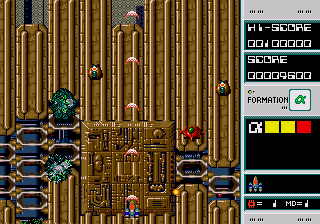 Namco’s first entry in the genre (it would soon be followed by Burning Force), Dangerous Seed is a top-down shmup that doesn’t look like much at first, but slowly grows on you as you play. The graphics are very arcadey-looking, and there isn’t much detail, but the game is never really ugly. True, it pales in comparison to the arcade original, but what can you do? The sound and music are also forgettable, which seems to be typical of this type of early Genesis shmup, but the gameplay is solid. My only gripe is that it can be too easy at times. Enemies tend to not fire at you when they are near the bottom of the screen, and your ship’s life bar erases any possible run for skill. This makes it far too easy to get through a level, as you practically don’t have to fire at or worry about almost half the screen. Compounding the problem is that you have between three and five lives at start, so a single credit can last a long time. The power up system is nothing too interesting either and seems quite primitive next to those of other games released at the same time. I wouldn’t recommend Dangerous Seed for a diehard shmup fan looking for a bullet-hell fix, but it’s worth spending some time with.
Namco’s first entry in the genre (it would soon be followed by Burning Force), Dangerous Seed is a top-down shmup that doesn’t look like much at first, but slowly grows on you as you play. The graphics are very arcadey-looking, and there isn’t much detail, but the game is never really ugly. True, it pales in comparison to the arcade original, but what can you do? The sound and music are also forgettable, which seems to be typical of this type of early Genesis shmup, but the gameplay is solid. My only gripe is that it can be too easy at times. Enemies tend to not fire at you when they are near the bottom of the screen, and your ship’s life bar erases any possible run for skill. This makes it far too easy to get through a level, as you practically don’t have to fire at or worry about almost half the screen. Compounding the problem is that you have between three and five lives at start, so a single credit can last a long time. The power up system is nothing too interesting either and seems quite primitive next to those of other games released at the same time. I wouldn’t recommend Dangerous Seed for a diehard shmup fan looking for a bullet-hell fix, but it’s worth spending some time with.
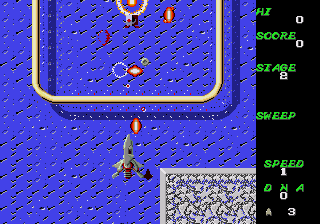 Another Data East game reprogrammed by Sega, Darwin 4081 tries to be innovative with its weapons system. As the name implies, your ship undergoes several evolutionary changes as you acquire power ups, making for some interesting combinations. Unfortunately, that’s about the only innovative thing about this game, as everything else is very bland and uninspired. For a game that came out on the Genesis in 1990, it doesn’t make the slightest attempt to use any of the system’s new capabilities and looks quite dated. The gameplay is adequate, but most people won’t get play long enough to realize this, since Darwin is just so ho-hum to look at. There is an upside, though. you can score a complete copy for next to nothing on eBay, and once you get past the aesthetics (it’s no aural picnic either), you’ll find that there’s a pretty entertaining little shmup under the dull sheen. Your ships’ evolution is pretty cool and this is a concept that should be brought back. Besides, what other shmup lets you use a flying squid?
Another Data East game reprogrammed by Sega, Darwin 4081 tries to be innovative with its weapons system. As the name implies, your ship undergoes several evolutionary changes as you acquire power ups, making for some interesting combinations. Unfortunately, that’s about the only innovative thing about this game, as everything else is very bland and uninspired. For a game that came out on the Genesis in 1990, it doesn’t make the slightest attempt to use any of the system’s new capabilities and looks quite dated. The gameplay is adequate, but most people won’t get play long enough to realize this, since Darwin is just so ho-hum to look at. There is an upside, though. you can score a complete copy for next to nothing on eBay, and once you get past the aesthetics (it’s no aural picnic either), you’ll find that there’s a pretty entertaining little shmup under the dull sheen. Your ships’ evolution is pretty cool and this is a concept that should be brought back. Besides, what other shmup lets you use a flying squid?
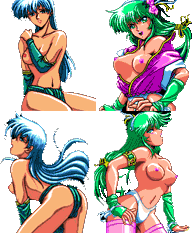 What the hell is this? A game centered around soft-core porn? Before you get any ideas, be warned that the work (yes, work) you’ll have to go through to actually see anything is more tedious than surfing the net for porn, and probably more rewarding. If you can bring yourself to play through an entire level of this horrid game, you’ll be given a static image of some anime lovely for your enjoyment. There’s a buttload of text to go with it all, and I would really like to know what the reason for all the nudity is. It appears that Earth’s last hope was some sort of a pimp, and our hero isn’t content with being the savior of mankind. He must make a booty call between stages! Seriously, all that’s missing is a pair of tentacles for the image to be complete. Bland, repetitive gameplay, virtually no power ups, and some of the worse music ever stuffed into a cart are enough to send this one packing. Even the bosses appeared bored, and their attack patterns are absurdly simple and predictable. Honestly, I cannot find a single redeeming feature about Divine Sealing, which is why some people will probably now seek out a copy. It at least makes for interesting conversation.
What the hell is this? A game centered around soft-core porn? Before you get any ideas, be warned that the work (yes, work) you’ll have to go through to actually see anything is more tedious than surfing the net for porn, and probably more rewarding. If you can bring yourself to play through an entire level of this horrid game, you’ll be given a static image of some anime lovely for your enjoyment. There’s a buttload of text to go with it all, and I would really like to know what the reason for all the nudity is. It appears that Earth’s last hope was some sort of a pimp, and our hero isn’t content with being the savior of mankind. He must make a booty call between stages! Seriously, all that’s missing is a pair of tentacles for the image to be complete. Bland, repetitive gameplay, virtually no power ups, and some of the worse music ever stuffed into a cart are enough to send this one packing. Even the bosses appeared bored, and their attack patterns are absurdly simple and predictable. Honestly, I cannot find a single redeeming feature about Divine Sealing, which is why some people will probably now seek out a copy. It at least makes for interesting conversation.
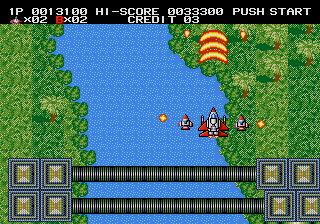 The ugly Engrish title you see above here is actually one of the pronunciations of the game’s real name, Earth Defense, Realtec’s unlicensed shmup that deservedly never got a seal of approval from Sega. To say that this game is bad is more than an understatement; it’s an injustice. The thing that impacted me the most is that Earth Defense was released in 1995, well into the twilight of the Genesis’ dominance. Where are all the graphical effects? Rockin’ soundtrack? Where’s the actual game? Worse than homebrew shareware, you need to stay as far away from this steaming pile as humanly possible. Horrible graphics, terrible sound, and EZ Doze gameplay are all the hallmarks of a bad shmup. Needless to say, Earth Defense qualifies in all areas. For all the shmups available on the Genesis, most are surprisingly good. The few that don’t measure up all bow in fear before this game. I’ve heard people buy Earth Defense just for the cheese factor; it seems that boasting about owning a turd is something of a trend nowadays. If that’s your thing, get this and a copy of Divine Sealing and be the envy of all your friends.
The ugly Engrish title you see above here is actually one of the pronunciations of the game’s real name, Earth Defense, Realtec’s unlicensed shmup that deservedly never got a seal of approval from Sega. To say that this game is bad is more than an understatement; it’s an injustice. The thing that impacted me the most is that Earth Defense was released in 1995, well into the twilight of the Genesis’ dominance. Where are all the graphical effects? Rockin’ soundtrack? Where’s the actual game? Worse than homebrew shareware, you need to stay as far away from this steaming pile as humanly possible. Horrible graphics, terrible sound, and EZ Doze gameplay are all the hallmarks of a bad shmup. Needless to say, Earth Defense qualifies in all areas. For all the shmups available on the Genesis, most are surprisingly good. The few that don’t measure up all bow in fear before this game. I’ve heard people buy Earth Defense just for the cheese factor; it seems that boasting about owning a turd is something of a trend nowadays. If that’s your thing, get this and a copy of Divine Sealing and be the envy of all your friends.
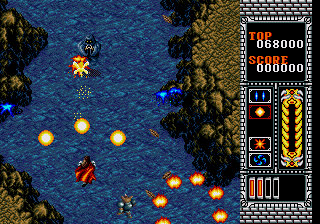 Typically, people associate Techno Soft with the Thunder Force series. They did, however, make a fine vertical shmup that was released in 1990 called Elemental Master. Though not as innovative or revolutionary as Thunder Force, it was still a solid title that’s great fun to play. Strangely enough, Renovation published it, even though Sega had handled most of Techno Soft’s previous outings (Herzog Zwei, Thunder Force 2).
Typically, people associate Techno Soft with the Thunder Force series. They did, however, make a fine vertical shmup that was released in 1990 called Elemental Master. Though not as innovative or revolutionary as Thunder Force, it was still a solid title that’s great fun to play. Strangely enough, Renovation published it, even though Sega had handled most of Techno Soft’s previous outings (Herzog Zwei, Thunder Force 2).
Visually, Elemental Master is nothing to write home about. The graphics are very middle-of-the-road and don’t really take advantage of the hardware. The gameplay is more or less on the same level, with your hero casting spells instead of lugging around a huge cannon of some sort. The bosses are a high point, as some of them are very well drawn and offer a decent challenge. Far too often, though, this game is compared to Techno Soft’s other famous franchise. That is both unfair and unnecessary. Elemental Master is a totally different type of game and honestly, were we to compare most shmups to Thunder Force III or Lightening Force, many would come up short. I take this game for what it is: a decent little shmup that doesn’t bring the house down but is still a fun and worthwhile purchase.
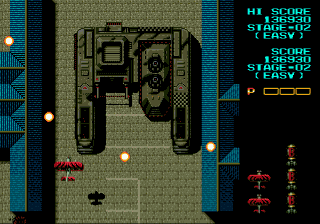 This is definitely one of my favorites! Yet another of Dreamworks great releases, Fire Shark was a great port that still holds up very well today. It was one of the first vertical shmups released for the Genesis, which is remarkable, considering how well it still plays and looks. I guess that had a lot to do with the arcade source material, and the Genesis port is very faithful to that version. I always wondered how come Fire Shark came out so well but Twin Cobra, which was released much later, was so mediocre. I guess it has to do with the fact that American Treco ported Twin Cobra, whereas Toaplan did Fire Shark themselves. The lack of a two-player mode brings it down a notch but the solid gameplay and decent graphics more than make up for that oversight. Weapons can be powered up to an insane level and you also have an incredibly powerful bomb that can be deployed in succession, for devastating damage. Although it’s a bit easy, Fire Shark is a great shmup that comes highly recommended.
This is definitely one of my favorites! Yet another of Dreamworks great releases, Fire Shark was a great port that still holds up very well today. It was one of the first vertical shmups released for the Genesis, which is remarkable, considering how well it still plays and looks. I guess that had a lot to do with the arcade source material, and the Genesis port is very faithful to that version. I always wondered how come Fire Shark came out so well but Twin Cobra, which was released much later, was so mediocre. I guess it has to do with the fact that American Treco ported Twin Cobra, whereas Toaplan did Fire Shark themselves. The lack of a two-player mode brings it down a notch but the solid gameplay and decent graphics more than make up for that oversight. Weapons can be powered up to an insane level and you also have an incredibly powerful bomb that can be deployed in succession, for devastating damage. Although it’s a bit easy, Fire Shark is a great shmup that comes highly recommended.
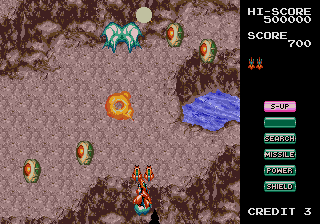 Ah, another Toaplan shmup. They’re my favorites, by far, and Grind Stormer does a good job of emulating its arcade relative. The graphics aren’t as clean or detailed here, and the sound has taken a hit, but the gameplay is intact. The weapon upgrade system is pretty standard, requiring you to power up each shot several times to increase effectiveness. They’re powerful too, and a fully powered blast can be a lovely thing to watch. If there’s anything particularly negative about Grind Stormer, it’s that the levels can sometimes be too long, and playing through the whole game can take a pretty fair chunk of time, something not typical for a shmup. That might actually be a good thing, as blowing through a game in 20 minutes, especially one meant to test your reflexes, tends to leave one with a desire for more.
Ah, another Toaplan shmup. They’re my favorites, by far, and Grind Stormer does a good job of emulating its arcade relative. The graphics aren’t as clean or detailed here, and the sound has taken a hit, but the gameplay is intact. The weapon upgrade system is pretty standard, requiring you to power up each shot several times to increase effectiveness. They’re powerful too, and a fully powered blast can be a lovely thing to watch. If there’s anything particularly negative about Grind Stormer, it’s that the levels can sometimes be too long, and playing through the whole game can take a pretty fair chunk of time, something not typical for a shmup. That might actually be a good thing, as blowing through a game in 20 minutes, especially one meant to test your reflexes, tends to leave one with a desire for more.
Tengen released Grind Stormer in the U.S. and I’ve heard of several people with faulty carts (happened to me too). Be sure to test before you buy.
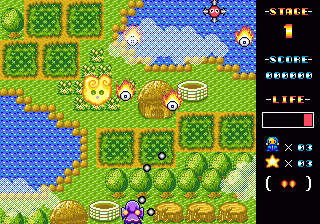 Don’t let Magic Girl‘s cute-’em-up facade fool you. This baby’s hard! Enemies swarm you from all sides (they mostly come from behind), and bullets are everywhere. Your little witch could give Cotton a run for her money though, with a pretty wide range of power ups, including many, many shields. Even though it comes at you with bright, colorful graphics and most of the enemies are cute little jelly monsters and stars, this is twitch gameplay through and through. Your meager little life bar drops faster than a stripper’s top on a Friday night, and the three bombs you start out with don’t do much at all. The bosses are fun and huge, and anyone who plays this will instantly know why Magic Girl wasn’t brought to the U.S., although Keio Flying Squadron is more or less in the same vein and was released here. If you can find a copy, which will be a chore, you need to pick this one up. I was very impressed with how well it played and looked and can recommend it wholeheartedly. Not all shmups need to pit one man against a fleet of mechanized alien invaders to be good, and Magic Girl is a great example of this.
Don’t let Magic Girl‘s cute-’em-up facade fool you. This baby’s hard! Enemies swarm you from all sides (they mostly come from behind), and bullets are everywhere. Your little witch could give Cotton a run for her money though, with a pretty wide range of power ups, including many, many shields. Even though it comes at you with bright, colorful graphics and most of the enemies are cute little jelly monsters and stars, this is twitch gameplay through and through. Your meager little life bar drops faster than a stripper’s top on a Friday night, and the three bombs you start out with don’t do much at all. The bosses are fun and huge, and anyone who plays this will instantly know why Magic Girl wasn’t brought to the U.S., although Keio Flying Squadron is more or less in the same vein and was released here. If you can find a copy, which will be a chore, you need to pick this one up. I was very impressed with how well it played and looked and can recommend it wholeheartedly. Not all shmups need to pit one man against a fleet of mechanized alien invaders to be good, and Magic Girl is a great example of this.
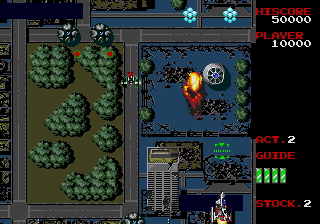 Oh my god. I cannot believe that I played this game for so long. What at first looks like a fun, back-to-basics shmup turns out to be the most underwhelming experience I’ve had doing this article. While I was initially enthusiastic about the combination of shooting and bombing (I love that), any good feelings I had towards this game disappeared as soon as I hit something. The sound of your fire has to be the single most grating and annoying effect in gaming. Seriously, play this game with your stereo too loud and you will blow your speakers; it’s that bad. The music is equally horrible, and only after I desperately hit the mute button was I able to actually play. Unfortunately, what was left was no better. It’s ironic that a shmup called Master of Weapon has one of the worst power ups in the genre. After taking on several capsules, your shot is no more powerful than it was when you started, and all are equally useless against the laughable bosses against which you have to fight. The worst culprit of all? The abnormally large hit box that gets you killed for even flying alongside a bullet. Blech. Avoid.
Oh my god. I cannot believe that I played this game for so long. What at first looks like a fun, back-to-basics shmup turns out to be the most underwhelming experience I’ve had doing this article. While I was initially enthusiastic about the combination of shooting and bombing (I love that), any good feelings I had towards this game disappeared as soon as I hit something. The sound of your fire has to be the single most grating and annoying effect in gaming. Seriously, play this game with your stereo too loud and you will blow your speakers; it’s that bad. The music is equally horrible, and only after I desperately hit the mute button was I able to actually play. Unfortunately, what was left was no better. It’s ironic that a shmup called Master of Weapon has one of the worst power ups in the genre. After taking on several capsules, your shot is no more powerful than it was when you started, and all are equally useless against the laughable bosses against which you have to fight. The worst culprit of all? The abnormally large hit box that gets you killed for even flying alongside a bullet. Blech. Avoid.
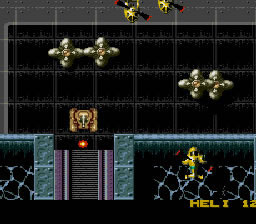 Known as Firepower 2000 on the SNES, Mega SWIV tells the tale of an underground army stealing military equipment from around the world to use against mankind. Yes, the story is cheesy, and the gameplay isn’t much better. Two people can play at the same time, but the game doesn’t get much better. The levels and enemies have supposedly been improved over the SNES version, and I’d hate to see what they were like if this is meant to be an improvement. It’s not that Mega SWIV is necessarily bad; it’s just so underwhelming that it lost my interest quite quickly. The firing system (especially for the jeep) is annoying, since you have to press once to fire, and once more to hold the direction. This can be a big pain when you’re attacked from all sides, even more so since touching the walls means instant death! Power ups are too sporadic and ineffective, and the music just gets on your nerves. Fortunately, you won’t have to live with the realization that you overspent on Mega SWIV, as it’s not all that expensive. I recommend buying Verytex or Fire Shark for your top-down shmup fix instead.
Known as Firepower 2000 on the SNES, Mega SWIV tells the tale of an underground army stealing military equipment from around the world to use against mankind. Yes, the story is cheesy, and the gameplay isn’t much better. Two people can play at the same time, but the game doesn’t get much better. The levels and enemies have supposedly been improved over the SNES version, and I’d hate to see what they were like if this is meant to be an improvement. It’s not that Mega SWIV is necessarily bad; it’s just so underwhelming that it lost my interest quite quickly. The firing system (especially for the jeep) is annoying, since you have to press once to fire, and once more to hold the direction. This can be a big pain when you’re attacked from all sides, even more so since touching the walls means instant death! Power ups are too sporadic and ineffective, and the music just gets on your nerves. Fortunately, you won’t have to live with the realization that you overspent on Mega SWIV, as it’s not all that expensive. I recommend buying Verytex or Fire Shark for your top-down shmup fix instead.
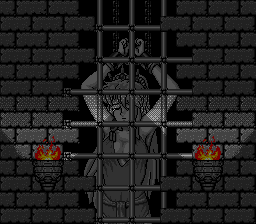 From Starbase299: For those old enough to remember, Namco did do some shooters long before they entered the fighting genre. Among them was this vertical scroller for the growing Genesis system. While it received some very high marks in the magazines back in the day as being a pretty good and intense shooter, it pales to that extent when looked at today, especially when compared to a few other shooters from the same time period. It’s not a bad game at all, just probably not worthy of a 9 like others had awarded it. While it has plenty of levels and some enemies to shoot at, it had some decent graphics and okay sounds to go along with it. The title is probably best only for a shooter freak’s collection or a game collector nowadays, as it’s becoming a harder game to find simply due to age. Namco collectors are probably out gobbling up the remaining copies too.
From Starbase299: For those old enough to remember, Namco did do some shooters long before they entered the fighting genre. Among them was this vertical scroller for the growing Genesis system. While it received some very high marks in the magazines back in the day as being a pretty good and intense shooter, it pales to that extent when looked at today, especially when compared to a few other shooters from the same time period. It’s not a bad game at all, just probably not worthy of a 9 like others had awarded it. While it has plenty of levels and some enemies to shoot at, it had some decent graphics and okay sounds to go along with it. The title is probably best only for a shooter freak’s collection or a game collector nowadays, as it’s becoming a harder game to find simply due to age. Namco collectors are probably out gobbling up the remaining copies too.
Ghostwalker pretty much summed up my feelings on Phelios. Have a different opinion? Why not read our review and see how it compares?
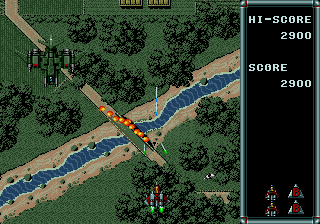 Sporting a $70 price tag at release, Raiden Trad was one of those games that kept people away. Given the fact that you could get Thunder Force III at the time for $20 less, I can see why. Of course, there were always a few people willing to risk it (read about one of them in vol. 2 of Stories from the Book of Genesis), but I doubt they got their money’s worth. Raiden Trad isn’t a bad game at all; I’m just not sure if it was worth that much cash. What you got was a solid entry in the series with a decent weapons system. There’s just nothing here to “wow” you. Although it’s not as colorful as its SNES sibling, I actually think it plays better. The Raiden series introduced me to top-down shmups, and it’s nice to see that it’s lasted as long as it has.
Sporting a $70 price tag at release, Raiden Trad was one of those games that kept people away. Given the fact that you could get Thunder Force III at the time for $20 less, I can see why. Of course, there were always a few people willing to risk it (read about one of them in vol. 2 of Stories from the Book of Genesis), but I doubt they got their money’s worth. Raiden Trad isn’t a bad game at all; I’m just not sure if it was worth that much cash. What you got was a solid entry in the series with a decent weapons system. There’s just nothing here to “wow” you. Although it’s not as colorful as its SNES sibling, I actually think it plays better. The Raiden series introduced me to top-down shmups, and it’s nice to see that it’s lasted as long as it has.
Note: I’ve seen two different versions of the box art (I got the ugly, green Micronet one), and I assume the other, red Bignet cover is rarer.
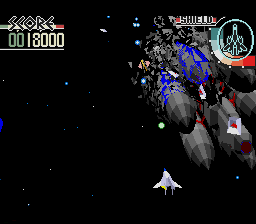 When it first appeared on the Sega CD back in 1993, Silpheed wowed gamers with some of the most incredible graphics available on any console at the time. Years later, the novelty has worn off and the flat-shaded polygons no longer impress like they used to; however, the game is as solid as ever. A traditional top-down shmup with a brutal difficulty level, Silpheed is still a great reason to own a Sega CD. Game Arts did a great job showing what the system was capable of, and the game screams quality on all levels. Simple in execution, it can sometimes be its own enemy, as gamers will tend to get distracted by the huge explosions or rotating backgrounds and end up losing a life. Even so, there’s no reason for you not to have this game in your collection.
When it first appeared on the Sega CD back in 1993, Silpheed wowed gamers with some of the most incredible graphics available on any console at the time. Years later, the novelty has worn off and the flat-shaded polygons no longer impress like they used to; however, the game is as solid as ever. A traditional top-down shmup with a brutal difficulty level, Silpheed is still a great reason to own a Sega CD. Game Arts did a great job showing what the system was capable of, and the game screams quality on all levels. Simple in execution, it can sometimes be its own enemy, as gamers will tend to get distracted by the huge explosions or rotating backgrounds and end up losing a life. Even so, there’s no reason for you not to have this game in your collection.
I’ve often wondered why people tend to ride Silpheed‘s gameplay but praise Axelay on the SNES. Both games are quite similar in that they make terrific use of their respective console’s special effects.
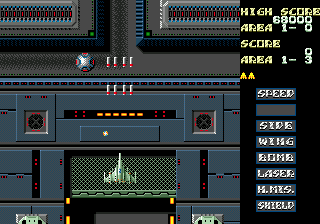 Wow, this is an interesting find. It’s not every day you see a game ported to a system that launched three years after it was released. Slap Fight, released in arcades in 1986, was a Toaplan game (seems to be a lot of them here) from the early days of vertical shmups. It finally made its way to the Genesis in 1993, via Tengen, and would have been terribly outdated, brought over intact. Thankfully, the developers saw fit to include an exclusive Mega Drive version, which is an entirely new game!
Wow, this is an interesting find. It’s not every day you see a game ported to a system that launched three years after it was released. Slap Fight, released in arcades in 1986, was a Toaplan game (seems to be a lot of them here) from the early days of vertical shmups. It finally made its way to the Genesis in 1993, via Tengen, and would have been terribly outdated, brought over intact. Thankfully, the developers saw fit to include an exclusive Mega Drive version, which is an entirely new game!
Similar to Astro Warrior in presentation, you collect stars instead of capsules to power up your weapons. As you collect them, your ship transforms until you attain the mighty Power Wing, which almost tripled your size and made for some great firepower. It takes a bit too long to get up to an acceptable speed, but other than that this game is great. The extra mode adds immeasurably to its shelf life and the action is enough to keep you coming back for more.
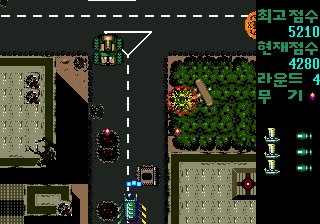 Now here’s a rarity for you. Distributed in Korea by Samsung, Space Turtle Battleship, or Keo-Buk-Son översatt, was released in 1992 and was promptly passed over by every U.S. publisher known to man. It’s a strange game, to be sure, and comes off as something of an amalgam of shmups from the era. One stage you’re in space, fighting off enemy craft Truxton-like, and the minute you’re tearing through an area that looks like it leapt from Twin Cobra. I can’t read Korean, but I’d really love to know how tanks and helicopters fit into all of this! There’s no relation to the classic anime Space Battleship Yamato, so forget that route, but there does seem to be some history involved here. Supposedly, the Korean Turtle Ships were ironclad crafts built in Korea in 1592 and helped the country defeat Japan. The man responsible, Admiral Yi, became one of the most famous military leaders in their history. Quite an interesting story, as historical backgrounds aren’t typical in the genre.
Now here’s a rarity for you. Distributed in Korea by Samsung, Space Turtle Battleship, or Keo-Buk-Son översatt, was released in 1992 and was promptly passed over by every U.S. publisher known to man. It’s a strange game, to be sure, and comes off as something of an amalgam of shmups from the era. One stage you’re in space, fighting off enemy craft Truxton-like, and the minute you’re tearing through an area that looks like it leapt from Twin Cobra. I can’t read Korean, but I’d really love to know how tanks and helicopters fit into all of this! There’s no relation to the classic anime Space Battleship Yamato, so forget that route, but there does seem to be some history involved here. Supposedly, the Korean Turtle Ships were ironclad crafts built in Korea in 1592 and helped the country defeat Japan. The man responsible, Admiral Yi, became one of the most famous military leaders in their history. Quite an interesting story, as historical backgrounds aren’t typical in the genre.
How this all relates to a vertical scrolling shmup is beyond me, but you can see the main vehicle is a turtle ship. The graphics and gameplay are decent enough, but I’m sure it will appeal to collectors more for its quirkiness and rarity than anything else.
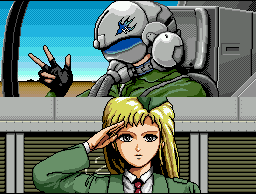 Treco’s second shmup on the Genesis fares much better than the first, with tighter gameplay and a great weapons system (good opening cut scene too!). Task Force Harrier EX puts you in the pilot seat of a modern jet armed with more weaponry than should be possible to fly with. Though the enemy sprites are small, they’re clear and well-detailed, and each stage is brimming with things to destroy. Of the whole package, I’m particularly impressed with the weapons options you receive. Having the ability to move them around M.U.S.H.A-style gives you greater freedom and ability to take out foes coming in from the sides and behind. The standard weapon is also quite powerful from the get-go, with a decent range of fire and auto bombing to eliminate foes on the ground. Your bomb set is kind of weak, but the overall strength of your firepower counteracts well enough. All in all, Task Force Harrier EX is pretty faithful to the arcade original and doesn’t tend to come up often whenever people discuss Genesis shmups. That’s a shame, as it’s a pretty darn good game.
Treco’s second shmup on the Genesis fares much better than the first, with tighter gameplay and a great weapons system (good opening cut scene too!). Task Force Harrier EX puts you in the pilot seat of a modern jet armed with more weaponry than should be possible to fly with. Though the enemy sprites are small, they’re clear and well-detailed, and each stage is brimming with things to destroy. Of the whole package, I’m particularly impressed with the weapons options you receive. Having the ability to move them around M.U.S.H.A-style gives you greater freedom and ability to take out foes coming in from the sides and behind. The standard weapon is also quite powerful from the get-go, with a decent range of fire and auto bombing to eliminate foes on the ground. Your bomb set is kind of weak, but the overall strength of your firepower counteracts well enough. All in all, Task Force Harrier EX is pretty faithful to the arcade original and doesn’t tend to come up often whenever people discuss Genesis shmups. That’s a shame, as it’s a pretty darn good game.
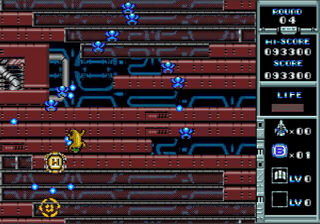 Another unlicensed title, this one hails from China and was released by Gametec. A slightly different version was also released for the Famicom, and both are quite rare. Like Space Turtle Battleship, Thunderbolt II is a game most people might mistake for a bootleg at first glance, but it is indeed a legit title. It has a decent weapons system, and it’s somewhat challenging, which makes it a good game for shooter fans looking for something new to play. A word of caution though: Thunderbolt II can be quite difficult to find, especially in complete condition, and such copies tend to fetch high prices. If you can find one though, it’s actually a fun little shmup that sports some decent presentation and gameplay. It’ll also make for one heck of a conversation piece in your collection. Just put it on the shelf next to Divine Sealing and watch the heads asplode!
Another unlicensed title, this one hails from China and was released by Gametec. A slightly different version was also released for the Famicom, and both are quite rare. Like Space Turtle Battleship, Thunderbolt II is a game most people might mistake for a bootleg at first glance, but it is indeed a legit title. It has a decent weapons system, and it’s somewhat challenging, which makes it a good game for shooter fans looking for something new to play. A word of caution though: Thunderbolt II can be quite difficult to find, especially in complete condition, and such copies tend to fetch high prices. If you can find one though, it’s actually a fun little shmup that sports some decent presentation and gameplay. It’ll also make for one heck of a conversation piece in your collection. Just put it on the shelf next to Divine Sealing and watch the heads asplode!
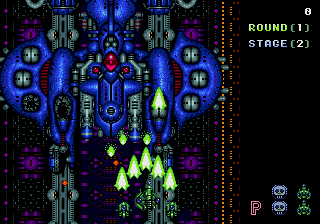 One of my favorite shmups of all time, Truxton was a Genesis launch title that some people blew off without ever giving a chance, due to its insane length. They don’t know what they’re missing. Press that start button and vertical scrolling madness ensues as you plow your way through five levels that are longer than the line at the DMV and harder than a pit bull’s bite. Weapon power ups are insane (three-way lasers!) and the bomb detonation still gives some people nightmares. The story is typical of most shmups: non-existent. That’s not a problem, as once you unleash the staggering fury of your SUPER FIGHTER’s weaponry upon your foes, powering up your weapon will be the only thing on your mind. A friend of mine said that you could only finish the game completely by beating it five times. In my innocence, I gleefully accepted the challenge only to find out that it wasn’t true. Still, I had a great time playing and the experience cemented my love of Truxton for all time.
One of my favorite shmups of all time, Truxton was a Genesis launch title that some people blew off without ever giving a chance, due to its insane length. They don’t know what they’re missing. Press that start button and vertical scrolling madness ensues as you plow your way through five levels that are longer than the line at the DMV and harder than a pit bull’s bite. Weapon power ups are insane (three-way lasers!) and the bomb detonation still gives some people nightmares. The story is typical of most shmups: non-existent. That’s not a problem, as once you unleash the staggering fury of your SUPER FIGHTER’s weaponry upon your foes, powering up your weapon will be the only thing on your mind. A friend of mine said that you could only finish the game completely by beating it five times. In my innocence, I gleefully accepted the challenge only to find out that it wasn’t true. Still, I had a great time playing and the experience cemented my love of Truxton for all time.
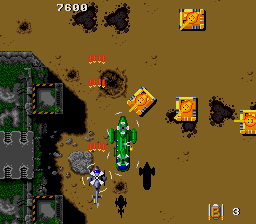 Ugh. I can’t say how disappointed I am at the way Twin Cobra turned out on the Genesis. Only marginally better than Tiger Heli on the NES, the game looks no better here. That says a lot, considering how amazing the arcade game was. I’m a big Toaplan fan, and this was something I was really looking forward to. Imagine my surprise at the underwhelming display I encountered upon first booting this up. The gameplay is mostly there, but the game looks so bad that it just took all the wind out of my sails. Everything is poorly detailed and animated, and the Toaplan charm that usually permeates throughout their games is blatantly absent. I don’t understand what happened here, as Fire Shark is simply amazing on the Genesis, and even Twin Hawk was decent. I guess things just didn’t pan out here, and the result is a mediocre game that looks much worse than a 16-bit port should.
Ugh. I can’t say how disappointed I am at the way Twin Cobra turned out on the Genesis. Only marginally better than Tiger Heli on the NES, the game looks no better here. That says a lot, considering how amazing the arcade game was. I’m a big Toaplan fan, and this was something I was really looking forward to. Imagine my surprise at the underwhelming display I encountered upon first booting this up. The gameplay is mostly there, but the game looks so bad that it just took all the wind out of my sails. Everything is poorly detailed and animated, and the Toaplan charm that usually permeates throughout their games is blatantly absent. I don’t understand what happened here, as Fire Shark is simply amazing on the Genesis, and even Twin Hawk was decent. I guess things just didn’t pan out here, and the result is a mediocre game that looks much worse than a 16-bit port should.
 You might know this one as Dai Sen Pu Hurricane, and if you don’t shame on you! Twin Hawk is lots of fun to play, although the lack of a two-player mode is a downer. Toaplan seems to have liked the Genesis a lot, and we got a bunch of their shmups (some better than others, right Twin Cobra?). World War II makes for all sorts of great games, and this is among the better games in the genre to use the theme. It foregoes the standard bomb set and instead gives you a small squadron of planes to call. They don’t last very long but do nicely at taking enemy fire, which makes things easier for you. This little import goodie has better than average graphics and decent sound, and plays very smoothly. The only problem I had was that they replaced the bomb, instead of adding the squadron along with it. Boss battles can be a bit more difficult and longer because of this. Regardless, Twin Hawk is still a solid game worth owning. It’s cheap and easy to find, so find a copy and have some fun!
You might know this one as Dai Sen Pu Hurricane, and if you don’t shame on you! Twin Hawk is lots of fun to play, although the lack of a two-player mode is a downer. Toaplan seems to have liked the Genesis a lot, and we got a bunch of their shmups (some better than others, right Twin Cobra?). World War II makes for all sorts of great games, and this is among the better games in the genre to use the theme. It foregoes the standard bomb set and instead gives you a small squadron of planes to call. They don’t last very long but do nicely at taking enemy fire, which makes things easier for you. This little import goodie has better than average graphics and decent sound, and plays very smoothly. The only problem I had was that they replaced the bomb, instead of adding the squadron along with it. Boss battles can be a bit more difficult and longer because of this. Regardless, Twin Hawk is still a solid game worth owning. It’s cheap and easy to find, so find a copy and have some fun!
 I’ve read many reviews of this game that compare it to Capcom’s arcade classic Commando and while I can see the resemblance, I have to argue that Undead Line has enough substance to stand on its own. The last of the “Forgotten Five,” it was left behind in Japan, depriving American Genesis gamers of an excellent title. It’s pretty straight forward in execution, and the graphics aren’t the best, but the gameplay is tight. The game has a fantasy tone to it rather than going for the typical sci-fi atmosphere of most shmups and this can be seen in everything from the enemies to the power ups, which appear in the form of treasure chests and can be shot to change them into the one you want.
I’ve read many reviews of this game that compare it to Capcom’s arcade classic Commando and while I can see the resemblance, I have to argue that Undead Line has enough substance to stand on its own. The last of the “Forgotten Five,” it was left behind in Japan, depriving American Genesis gamers of an excellent title. It’s pretty straight forward in execution, and the graphics aren’t the best, but the gameplay is tight. The game has a fantasy tone to it rather than going for the typical sci-fi atmosphere of most shmups and this can be seen in everything from the enemies to the power ups, which appear in the form of treasure chests and can be shot to change them into the one you want.
There is definitely reason to own Undead Line and the prices it achieves regularly on eBay are testament to that fact. Having made some progress in completing my Genesis collection (166 games and counting!), I’m planning to tackle the Forgotten Five full steam soon. I already have Panorama Cotton, and this will probably be the next one I go after.
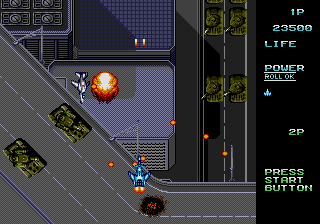 Eight meg power! The thing that stands out most in my mind when I think of Vapor Trail is how much it cost when it first came out. Nowhere in my local area was it sold for less than $69.99, and after playing it, I can’t for the life of me see why this was so. Not that the game is bad or anything, but it simply doesn’t produce the kind of experience that you’d expect from a shmup that expensive, especially when there are cheaper games in the genre that play much better. The two-player mode is nice, and the whole package overall does a good job of emulating the arcade original. Very arcadey and frantic, with some a good weapons system, Vapor Trail becomes much more interesting when you bring a friend along for the ride. Choose from one of three different ships and battle your way through several graphically underwhelming cities. Just don’t get lost in all the bullet mayhem onscreen (as happens in two-player shmups sometimes).
Eight meg power! The thing that stands out most in my mind when I think of Vapor Trail is how much it cost when it first came out. Nowhere in my local area was it sold for less than $69.99, and after playing it, I can’t for the life of me see why this was so. Not that the game is bad or anything, but it simply doesn’t produce the kind of experience that you’d expect from a shmup that expensive, especially when there are cheaper games in the genre that play much better. The two-player mode is nice, and the whole package overall does a good job of emulating the arcade original. Very arcadey and frantic, with some a good weapons system, Vapor Trail becomes much more interesting when you bring a friend along for the ride. Choose from one of three different ships and battle your way through several graphically underwhelming cities. Just don’t get lost in all the bullet mayhem onscreen (as happens in two-player shmups sometimes).
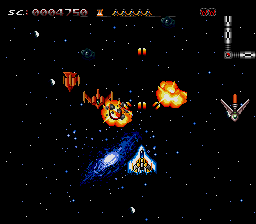 Most people will pass right by Verytex without giving it a second thought, and by doing so, miss one of the better vertical shmups on the Genesis. It reminds me a lot of the Turbo Grafx-16 classic Blazing Lazers, in style and gameplay, and that is a good thing. I can imagine that there will be comparisons to Compile’s masterpiece M.U.S.H.A., but that would be unfair, I think. Verytex plays a lot slower than that game and is less about huge bosses and dodging. I know, you’re thinking but what’s so special about it then? Its simplicity. It never tries to be anything huge and is a better game because of it. Everything is well done, from the graphics to the power ups and difficulty level. You might not be blown away from its intensity, but you will appreciate what a solid shmup it is. This one is relatively unknown to most Genny gamers, and fans of the genre would do well to find a copy and give it a try. I was quick to dismiss it, and now see how wrong I was. It’s a great little game.
Most people will pass right by Verytex without giving it a second thought, and by doing so, miss one of the better vertical shmups on the Genesis. It reminds me a lot of the Turbo Grafx-16 classic Blazing Lazers, in style and gameplay, and that is a good thing. I can imagine that there will be comparisons to Compile’s masterpiece M.U.S.H.A., but that would be unfair, I think. Verytex plays a lot slower than that game and is less about huge bosses and dodging. I know, you’re thinking but what’s so special about it then? Its simplicity. It never tries to be anything huge and is a better game because of it. Everything is well done, from the graphics to the power ups and difficulty level. You might not be blown away from its intensity, but you will appreciate what a solid shmup it is. This one is relatively unknown to most Genny gamers, and fans of the genre would do well to find a copy and give it a try. I was quick to dismiss it, and now see how wrong I was. It’s a great little game.
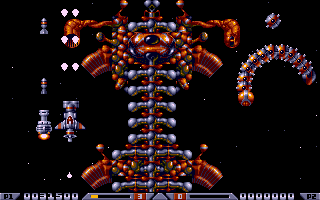 Another Amiga port, this one done by the famous Bitmap Brothers, Xenon 2 definitely has that Euro feel (its graphical style reminds me a lot of the original Turrican). The sound is nothing special, but it’s gameplay that counts, and thankfully Xenon 2 doesn’t falter here. It moves along at an acceptable pace most of the time, except for some slowdown in certain areas. The whole pace of the game is slow for a top-down shmup, and it this can make it seem to drag in places. I’ve never played the original, so I can’t comment on how it compares, but it’s not that bad for what it is, considering the competition it has. Xenon 2 was never released on the Genesis in the U.S., so you’ll have to track down a PAL copy if you’re looking to give it a spin. You won’t be disappointed, but just don’t expect to be blown away.
Another Amiga port, this one done by the famous Bitmap Brothers, Xenon 2 definitely has that Euro feel (its graphical style reminds me a lot of the original Turrican). The sound is nothing special, but it’s gameplay that counts, and thankfully Xenon 2 doesn’t falter here. It moves along at an acceptable pace most of the time, except for some slowdown in certain areas. The whole pace of the game is slow for a top-down shmup, and it this can make it seem to drag in places. I’ve never played the original, so I can’t comment on how it compares, but it’s not that bad for what it is, considering the competition it has. Xenon 2 was never released on the Genesis in the U.S., so you’ll have to track down a PAL copy if you’re looking to give it a spin. You won’t be disappointed, but just don’t expect to be blown away.
Click to the next page to see all the other types of shmups on the Genesis, Sega CD, and 32X!



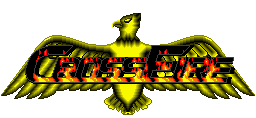
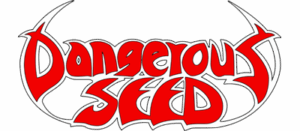
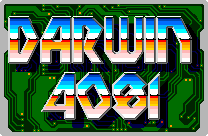


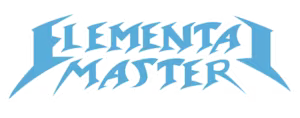




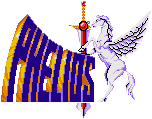
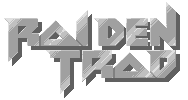


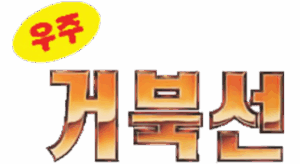
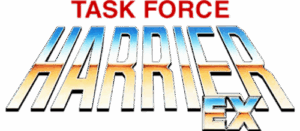
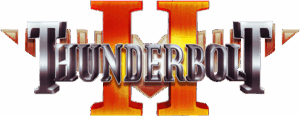
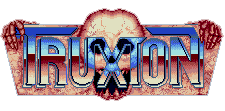

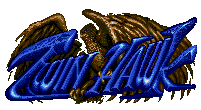
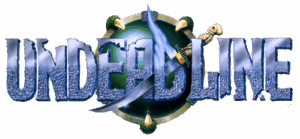
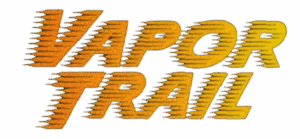
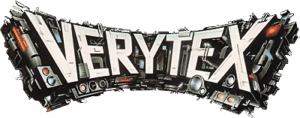

Recent Comments